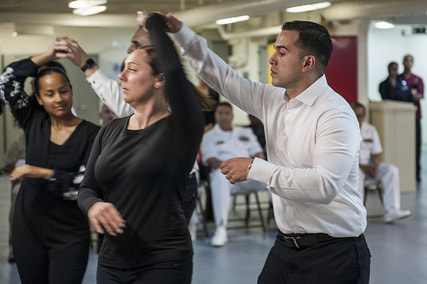|
When students are looking for a place to learn dance, or perhaps even a new place to learn, they will often want to know that they are being taught the proper way to dance. This raises the question: What is proper dance? Different people will use different ideas to determine if the dance being taught is proper. Let's consider some. Traditional If you can find the way the dance was danced in its home country and at the time it was conceived, then surely that must be the proper way to dance it. This is an approach that is often used in the less formalised dances such as swing and street Latin. However, it is often hard to determine the period in history that would be considered the time the dance was proper. Further, even if you go to the originating country, you will find that people there would dance it differently depending upon the part of that country they are from. Even different parts of Buenos Aires exhibit different styles of tango so travelling to Argentina will not allow you to be certain you are dancing proper tango. Standardised dances Dances such as Waltz, Samba, cha cha, Foxtrot, Jive and quickstep have been codified by international dance organisations. This standardisation and agreement by the respective committees lends some authority to the standardisation. One could consider these to be proper. However, these dances are the standardisation of other dances that had already been developed by other communities. Further, sometimes the standardisation would be performed by people who were unfamiliar with the culture that originated the dance. The end effect was that the dance that came about was a corruption of the original. It is hard to argue that this is proper. Dance sport Dance sport dance has much in common with the standardised dances. It is often those standards that are used for judging. However, dance sport does allow for evolution. If you watch videos from dance sport competitions from decades in the past, then you will see a marked difference in the nature of the dance. This continued evolution of better dance in the crucible of competition would produce a better dance that would at least be getting close to something one could call proper. The thing is that dance sport had its origins within the working-class dancers who wanted to be evaluated and compared to each other. The dancers of aristocracy danced for pleasure and to show civility. You could possibly imagine how an aristocrat might respond to the notion of being judged by another on how well they danced and compared to others: not well! These are two competing views of dance and both seem valid (one to dance to the best of precision and be the best there it and the other to dance for the cultural, social and pleasurable benefits that come with it). It is thus hard to argue that we have found an avenue to proper dance. Each of the above ideas has provided some ideas on what proper dance is. However, flaws can also be found in each. The same would likely be true of any other idea put forward on what makes for proper dance. If none of the above (or other) ideas can provide complete insight into what proper dance is, then what are we to conclude? It probably means that the question is not well formed. Or, that it assumes that dance is the type of thing that can be described as proper. If we take a moment to compare what dance is, then we can reformulate the question, and students can then find a way to evaluate a dance school or studio. What do we know about dance? The following is probably hard to argue with:
So when you are looking for a dance studio, ask about how they can help you explore dance so you can get what you want.
10 Comments
|
AuthorThis blog is written by the staff at Destine Dance and is inspired by the questions and challenges faced by our students Archives
July 2024
Categories
All
|

 RSS Feed
RSS Feed